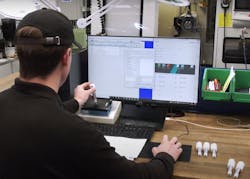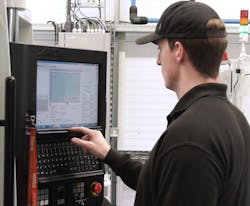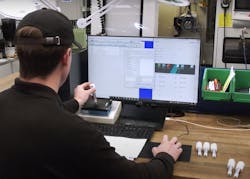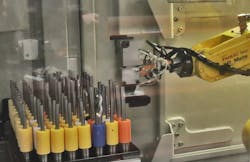Measurement and robotics help meet the need for smaller batches and shorter lead times
Marlor Tooling in Peterborough, England, designs and manufactures precision cutting tools for diverse clients. The company has focused on innovative solutions using the latest equipment and software to serve the aerospace, automotive, energy and woodworking industries. For two decades, Marlor Tooling has manufactured cutting tools for a range of industries and for one-off runs or volume batch manufacturing, and it delivers a diverse range of tools for customers with constantly changing needs.
For small batch regrinding, or for regrinding a single tool or a mixture or tools, Marlor Tooling wanted a better solution for chaotic regrinding. It needed a machine that could load a wider range of tool diameters. In 2020, Marlor Tooling found the answer with ANCA’s latest CNC machine, the MX7 Linear. Through the use of automation, chaotic loading is possible with robotics and an automated measurement tool.
The CNC tool grinder also uses the RoboMate loader, which includes a Fanuc LR Mate 200iD robot, to load tools from 3 mm up to 16 mm diameter, with the LaserPlus system, which provides accurate and repeatable measurement of the tools inside the machine.
“We have the ultimate in flexibility here,” says Adrian Wright, regional sales manager, UK, at ANCA. “When you combine this system with the LaserPlus or LaserUlta that can measure the tools in-process, you can intermingle the tools. So, it doesn’t matter if it is a regrind tool or a newly manufactured tool, we can slot in any tooling and it is the solution for everything.”
Typically, the LaserPlus can achieve +/- 3 microns accuracy or better. “An air blast unit ensures that coolant or contaminants are cleaned from the tool to ensure nothing hinders the measurement process,” Wright says.
RFID works in conjunction with collet changing, using one collet rack and a collet adapter (Figure 3). “The robot loading system chooses the required collet size from the rack to match the diameter of tool to be ground. This means varying shank diameters can be handled without operator intervention,” Wright says.
“The chip is important as it enables the tool type and grinding cycle to be associated with a specific tool/carrier combination (Figure 4). This means a mix of tool types can be loaded into the pallet and the machine can identify the information from the chip on the fly,” Wright says. “RFID saves setup time and increases productivity.”
ANCA machines use LinX cylindrical linear motors for axis motion. They have a neutral magnetic field with no additional load on the machine rails and a reduced heat source on axis saddles and reduced thermal growth, Wright says. The coolant system cools the motor without the need for a separate cooling system and prevents thermal growth, which could cause the machine to expand under excess heat from unchilled coolant or ambient temperatures. The ANCA machine has a polymer concrete base and coolant-chilled motors to reduce thermal growth.
An IP67 rating also means the magnets and windings are fully enclosed and protected. “LinX cylindrical linear motors use less power and energy than traditional flatbed linear motors,” says Wright. “The new cylindrical linear motor design increases reliability further and ensures a superior surface finish.” Used in conjunction with linear scales, the linear motors achieve superior tool accuracy, which isn’t affected over time due to wear or temperature variations. “The LinX Linear Motor has higher axis speed and acceleration, leading to reduced cycle times,” Wright says.
With two pallets in the machine, the ANCA MX 7 Linear can accommodate up to 200 tools. Wright says customers from all industries are continuing to demand shorter lead times on cutting tools even for smaller batches. Operators can change as many tools as they need to ensure a fast turnaround when needed. This has also vastly improved lead times overall. Marlor Tooling went, on average, from a three-week lead time for tools down to a 24-hour lead time.
Taylor says Marlor Tooling also does programming off-line, which saves time. “We don’t have to stop the machine to do our programming, as the machine is automatically loading the next tool constantly,” he says.
About the Author
Anna Townshend
Managing Editor
Anna Townshend has been a writer and journalist for 20 years. Previously, she was the editor of Marina Dock Age and International Dredging Review, until she joined Endeavor Business Media in June 2020. She is the managing editor of Control Design and Plant Services.

Leaders relevant to this article:





